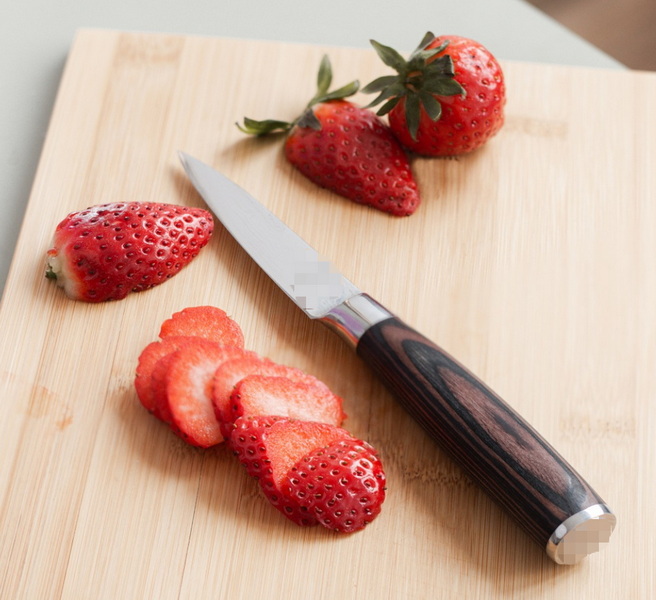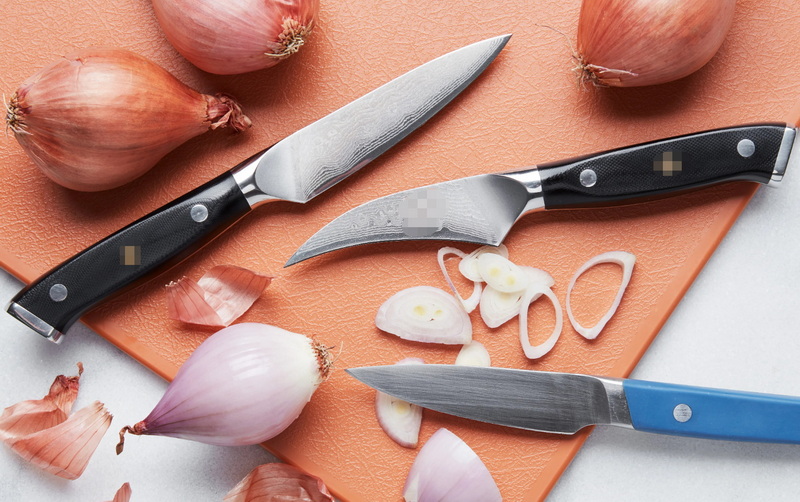- All
- Product Name
- Product Keyword
- Product Model
- Product Summary
- Product Description
- Multi Field Search
Views: 222 Author: Ann Publish Time: 2025-10-23 Origin: Site











Content Menu
● Understanding the Role of a Paring Knife
>> Handle design and ergonomics
>> Size and geometry considerations
>> Material science notes for OEM discussions
>> Practical buyer guidance for OEM clients
>> 1. What is the ideal blade material for a Paring Knife?
>> 2. How should a Paring Knife be sharpened for best results?
>> 3. What blade length is best for general use?
>> 4. Is a forged Paring Knife worth the extra cost?
>> 5. How should I care for and store a Paring Knife to maximize longevity?
A paring knife is the tiny, versatile workhorse of the kitchen. For brands, wholesalers, and manufacturers offering OEM kitchen tools, a well-designed paring knife can be a core product that demonstrates precision, balance, and durability. This article explains the essential features that define a good paring knife, how each feature affects performance, and practical guidance for selecting, testing, and marketing paring knives in international markets. Throughout, we emphasize the keyword Paring Knife to support SEO and brand positioning for OEM discussions and product specifications. The paring knife is often the first knife a home cook learns to use, yet it remains indispensable to professional chefs for tasks that demand precision, such as peeling eyes from potatoes, de-veining shrimp, or creating delicate garnishes. In an OEM context, the ability to customize blade material, handle design, and packaging while maintaining consistent quality is critical for success across diverse regions.

A Paring Knife is a short-bladed tool designed for delicate tasks such as peeling, trimming, slicing small fruits and vegetables, and intricate decorative work. The blade length typically ranges from 2.5 to 4 inches (6.4 to 10 cm). A good Paring Knife excels at control, precision, and comfortable handling, enabling precise cuts without slipping or fatigue. In many kitchens, the paring knife functions as the go-to tool for shaping, peeling, coring, and fine trimming around eyes and blemishes. For OEM programs, highlighting a versatile Paring Knife that can perform multiple micro-tasks with one tool adds tremendous value to brand partners seeking efficiency in product lines and inventory.
- Blade material: The blade should resist corrosion, hold a sharp edge, and be easy to resharpen. Common materials include high-carbon stainless steel, Japanese VG-series steels (VG-10, VG-MAX, and similar), and stainless alloys with good edge retention. For OEM offerings, specifying a corrosion-resistant steel that performs well in humid climates and with citrus exposure is advantageous.
- Blade geometry: A partial or full flat grind, a slender blade tip, and a balanced blade profile contribute to clean cuts and fine control. A comfortable tip shape helps with tasks like peeling eyes from potatoes or coring strawberries. The geometry should allow precise control for scooping out potato eyes or precision peeling around irregular curves.
- Edge retention: A good Paring Knife maintains a crisp edge through routine use, with an edge that's easy to touch up on a rod or stone. For OEM customers, offering options for edge hardness that balance sharpenability with longevity can differentiate products in different market segments.
- Hardness: A rockwell hardness in the range of HRC 58–63 balances edge retention with ease of sharpening, depending on alloy and heat-treatment. The final heat-treatment protocol should reflect the intended market: higher hardness for premium lines and slightly softer variants for budget lines that are easier to resharpen in home settings.
- Material: Handles may be polyoxymethylene (POM), pakkawood, micarta, natural wood, or other synthetic/resin composites. The material should be durable, dishwasher-safe, and provide a secure grip. For OEM programs, consider offering antimicrobial treatments or food-contact compliant coatings to appeal to institutional buyers.
- Tang and balance: Full tang construction improves balance and control, particularly for detailed work. A well-balanced Paring Knife reduces wrist fatigue during extended use. In some markets, visibility of craftsmanship and the seamless transition between blade and handle communicates quality at a glance.
- Comfort and grip texture: Slight texturing, gentle finger notches, and a contoured spine help maintain grip, even with damp hands. Textured scales or haptic patterns can enhance grip without compromising cleaning ease.
- Forged vs stamped: Forged blades often offer better balance and strength, while stamped blades can be more economical and lighter. For premium Paring Knives, forged construction is common. In OEM programs, offering both options allows buyers to optimize cost vs performance across regions.
- Blade-to-handle fit: Tight, seamless joins prevent food from lodging and improve hygiene. Tolerances affect performance and user confidence.
- Polish and finish: A smooth, aligned edge with minimal visible gaps enhances cutting performance and aesthetics. A mirror finish may be preferred for luxury lines, while satin or matte finishes can reduce glare in professional kitchens.

- Blade length: Most users prefer 3.5 inches (9 cm) as a versatile standard for a Paring Knife, with 2.5–3 inches for precision tasks and 3.75–4 inches for broader use. Offering a small family of sizes enables retailers to meet varied consumer preferences.
- Point shape: A sharp, slender tip enables intricate work, while a rounded tip can be safer for beginners. For certain culinary schools or institutional buyers, rounded tips can be an attractive safety feature.
- Overall weight: Lighter knives reduce fatigue, but some users prefer a bit more heft for steady control during precision tasks. Weight distribution (front-heavy vs balanced) affects how the knife feels in hand and how easily it maneuvers around curves.
- Corrosion resistance: Stainless steel or coated blades resist rust when used with moisture and citrus. For shared equipment in commercial kitchens, corrosion resistance is especially important.
- Sharpening ease: Paring Knives should respond well to common sharpening methods (stones, rods, pull-stroke systems). Labelling maintenance steps helps customers keep the edge longer. OEM partners can include guided sharpening instructions or video tutorials to reduce customer support needs.
- Micro-damage resistance: A robust edge geometry helps resist chipping during delicate tasks such as trimming citrus peels or deboning small items. Reinforcing the blade with a robust secondary bevel can improve durability for high-usage environments.
- Precision cuts: The knife should yield clean, precise slices without tearing. A well-tuned blade geometry minimizes resistance and reduces the risk of slipping.
- Control in detail work: A well-balanced Paring Knife gives the user confidence to perform intricate peeling, trimming, and decorative cuts.
- Safety considerations: A secure grip, appropriate blade length, and safe storage all contribute to safer operation. Provide integrated safety features in packaging or housings to reduce dulling and accidents in busy kitchens.
- High-carbon stainless steels offer excellent edge retention and corrosion resistance, but require mindful care to prevent rust in high-porosity environments. Alloy composition and heat treatment strategies influence performance, so providing technical datasheets helps buyers compare options.
- Japanese steel options often provide exceptional edge geometry, but may require expert sharpening in some markets. Assess availability of skilled sharpening partners and training for local service centers.
- Handle materials should meet global regulations for food-contact use and be tested for dishwasher compatibility where relevant. Consider offering finish options such as matte, gloss, or textured to align with brand identity.
- Define core use cases: For a Paring Knife intended for home cooks vs. professionals, specify edge retention needs, ease of sharpening, and handle durability. Align these with country-specific cooking styles and menu demands.
- Set performance metrics: Provide blade hardness targets, edge geometry, and finish standards to ensure consistency across production runs. Include acceptance criteria for surface defects, blade straightness, and handle attachment strength.
- Plan packaging and branding: Consider packaging that highlights blade material, hardness, and care instructions, with options for private labeling and custom logos. Offer recyclable or compostable packaging to appeal to eco-conscious markets.
A good Paring Knife combines thoughtful blade material, precise geometry, ergonomic handling, and robust construction. For OEM partners, aligning blade hardness, edge retention, and handle durability with market requirements across North America, Europe, and Asia will strengthen product credibility. By integrating high-quality images and videos, marketing teams can showcase performance and build trust with buyers seeking reliable Paring Knife options.

Answer: The ideal blade material balances hardness, corrosion resistance, and ease of sharpening. Common choices include high-carbon stainless steels and Japanese VG-series steels. For OEM projects, select a steel that performs well across target markets, resists rust in humid environments, and remains easy to sharpen with standard tools.
Answer: Use a fine-grit sharpening stone or a dedicated rod with a light, consistent angle (typically 15–20 degrees per side for many paring knives). Regular touch-ups maintain edge geometry, while periodic regrinding restores a worn bevel. Providing OEM buyers with step-by-step sharpening guides or videos reduces support needs.
Answer: The most versatile length is around 3.5 inches (9 cm). Shorter blades (2.5–3 inches) excel in precision tasks, while longer paring knives (3.75–4 inches) cover broader peeling and trimming work. Offer a small family of sizes to meet diverse consumer preferences.
Answer: Forged blades typically offer better balance, edge stability, and overall durability, which is valued by professional kitchens and serious home cooks. For OEM programs, provide both forged and stamped options to optimize cost-performance trade-offs for different market segments.
Answer: Hand wash with mild detergent and dry promptly. Avoid dishwasher exposure for most handle materials. Store in a knife block, magnetic strip, or protective sheath to prevent edge damage. Provide care instructions and maintenance tips in packaging or on the product page.
The Ultimate Professional Knives for Halal Butchery in Middle Eastern Kitchens
Chef Knife Size Guide: Choosing Between 6″, 8″, 10″, And 12″
Custom Knife Handles: How To Design A Chef Knife That Fits Your Hand Perfectly
Chef Knife Surface Treatments Guide: From Polished Migaki To Damascus Patterns
Inside Our Professional Knife Sample Room: Quality You Can See
Universal Knife Block Buying Guide: Modern Acrylic & ABS Knife Holders for Professional Kitchens
Universal Knife Block: The Complete Guide To Modern, Hygienic Knife Storage
The Complete Guide To Red Handle Knife Sets: Style Meets Functionality in The Kitchen
Professional Knives for Halal Butchery And Middle Eastern Cuisine